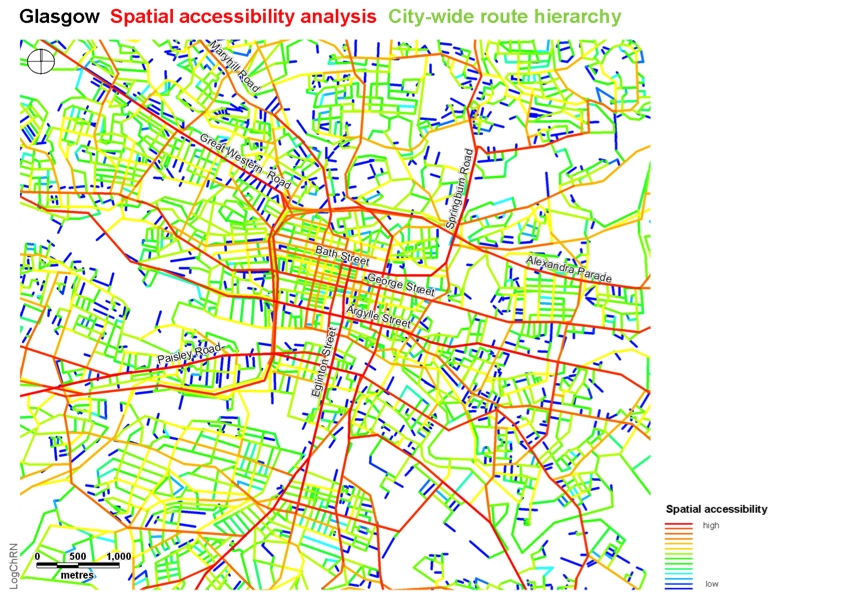
Space Syntax's model of Glasgow's existing Spatial Infrastructure
Space Syntax is featured in Glasgow’s winning bid to the Technology Strategy Board for £24 million of funding to demonstrate how a city of the future will work. Space Syntax director Tim Stonor said: “I’m delighted that Glasgow has been successful. The city delivered an ambitious bid and we look forward to playing a part in delivering it.”
Extract from the Glasgow Future Cities Demonstrator Feasibility Study:
Active Travel Spatial Analysis
Active Travel has been identified as a key component of a Scottish Government Health Programme that is taking a whole-system approach to improving healthy life expectancy in Scotland (Sir Harry Burns, Chief Medical Officer, August 2012).
Active Travel is an integration of city systems in itself demonstrating economic, health and quality of life benefits while contributing to environmental sustainability and encouraging use of alternative modes of transport.
A key opportunity to benefit from the integrated use of innovative technology in the arena of active travel was identified through discussions with Glasgow Centre for Population Health (GCPH) and a UK company called Space Syntax, facilitated by IBM. There is a strong desire within Glasgow for a properly integrated, safe, accessible and attractive infrastructure for active and sustainable modes of travel to increase the number of everyday journeys made by walking and cycling, reduce traffic congestion and pollution, achieve greater social interaction and improve fitness and physical health. There could also be boosts for tourism if Glasgow was seen as a city where it was easy to walk, cycle and access the range of public transport options available.
Companies like Space Syntax would focus resources on key individuals and organisations to identify and map the current infrastructure for active and sustainable modes of travel in Glasgow on a city-wide basis. The output from this would then be an essential tool for day-to-day use by individuals, has the potential to be used in application development by innovative entrepreneurs and could be used as the basis for future option appraisal and public realm development within the city ie as input into the current City Centre Strategy, as part of a feasibility study for the introduction of mandatory speed limits, a reference tool for future changes to street layout, planned developments and use of shared public space etc.
Using the data repository as a platform to build and integrate community mapping of the Glasgow area, citizens would be able to update information directly via the MyGlasgow Smartphone App and access visually through City Observatory environments.
The spatial analysis would analyse the current condition of Glasgow’s active travel network as the basis for a future strategic vision. This would be a first step towards making active travel much easier and better supported within Glasgow. Mapping how the active travel infrastructure co-exists with public transport infrastructure and services would be a further extension of this innovative approach. This work would coincide with additional infrastructure developments that are already taking place to develop the network of walking and cycling routes across Glasgow – for example, completion of the ‘Bridge to Nowhere’ project in Spring 2013 will provide a key link to Central Station for commuters.
Spatial analysis can “reveal unseen opportunities and create new ideas.”
www.spacesyntax.com
Glasgow City Council is currently undertaking a Feasibility Study for the provision of a mass cycle scheme within Glasgow but the timescales involved deemed that this project was outwith the scope of the TSB Future Cities Demonstrator Proposal.
“Glasgow is aiming to make cycling the biggest participatory activity in the city by 2020 as part of an ambitious bid to capitalise on the sport’s surge in popularity.”
Herald Scotland
Technology Strategy Board press release
Glasgow Future Cities Demonstrator Feasibility Study
Tim Stonor’s presentation”Future Cities – cities of transaction”
